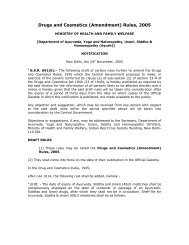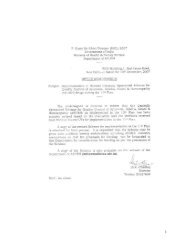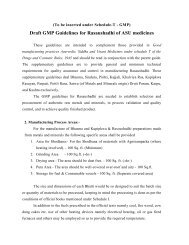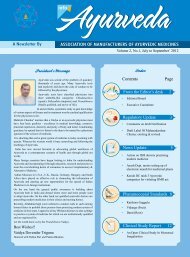3 In the Drugs and Cosmetics Rules, 1945 - amam-ayurveda.org
3 In the Drugs and Cosmetics Rules, 1945 - amam-ayurveda.org
3 In the Drugs and Cosmetics Rules, 1945 - amam-ayurveda.org
Create successful ePaper yourself
Turn your PDF publications into a flip-book with our unique Google optimized e-Paper software.
24Appendix IIIANIMAL TOXICOLOGY (NON-CLINICAL TOXICITY STUDIES)1. General PrinciplesToxicity studies should comply with <strong>the</strong> norms of Good Laboratory Practice (GLP). Briefly,<strong>the</strong>se studies should be performed by suitably trained <strong>and</strong> qualified staff employing properlycalibrated <strong>and</strong> st<strong>and</strong>ardized equipment of adequate size <strong>and</strong> capacity. Studies should be doneas per written protocols with modifications (if any) verifiable retrospectively. St<strong>and</strong>ardoperating procedures (SOPs) should be followed for all managerial <strong>and</strong> laboratory tasksrelated to <strong>the</strong>se studies. Test substances <strong>and</strong> test systems (in-vitro or in-vivo) should beproperly characterized <strong>and</strong> st<strong>and</strong>ardized. All documents belonging to each study, including itsapproved protocol, raw data, draft report, final report, <strong>and</strong> histology slides <strong>and</strong> paraffin tissueblocks should be preserved for a minimum of 5 years after marketing of <strong>the</strong> drug.Toxicokinetic studies (generation of pharmacokinetic data ei<strong>the</strong>r as an integral component of<strong>the</strong> conduct of non-clinical toxicity studies or in specially designed studies) should beconducted to assess <strong>the</strong> systemic exposure achieved in animals <strong>and</strong> its relationship to doselevel <strong>and</strong> <strong>the</strong> time course of <strong>the</strong> toxicity study. O<strong>the</strong>r objectives of toxicokinetic studiesinclude obtaining data to relate <strong>the</strong> exposure achieved in toxicity studies to toxicologicalfindings <strong>and</strong> contribute to <strong>the</strong> assessment of <strong>the</strong> relevance of <strong>the</strong>se findings to clinical safety,to support <strong>the</strong> choice of species <strong>and</strong> treatment regimen in nonclinical toxicity studies <strong>and</strong> toprovide information which, in conjunction with <strong>the</strong> toxicity findings, contributes to <strong>the</strong> designof subsequent non-clinical toxicity studies.1.1 Systemic Toxicity Studies1.1.1 Single-dose Toxicity Studies: These studies (see Appendix I item 4.2) should becarried out in 2 rodent species (mice <strong>and</strong> rats) using <strong>the</strong> same route as intended forhumans. <strong>In</strong> addition, unless <strong>the</strong> intended route of administration in humans is onlyintravenous, at least one more route should be used in one of <strong>the</strong> species to ensuresystemic absorption of <strong>the</strong> drug. This route should depend on <strong>the</strong> nature of <strong>the</strong>drug. A limit of 2g/kg (or 10 times <strong>the</strong> normal dose that is intended in humans,













![[To be published in Gazette of India Part II Section 3, sub-section iii]](https://img.yumpu.com/28570283/1/190x245/to-be-published-in-gazette-of-india-part-ii-section-3-sub-section-iii.jpg?quality=85)


